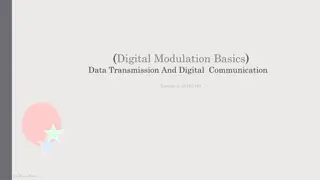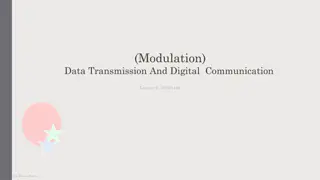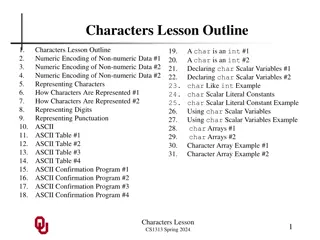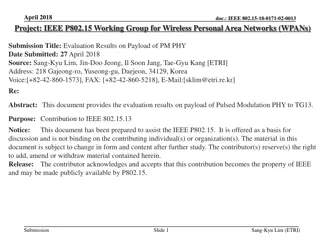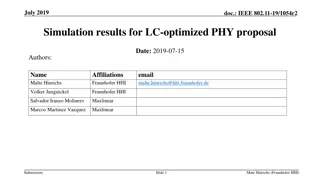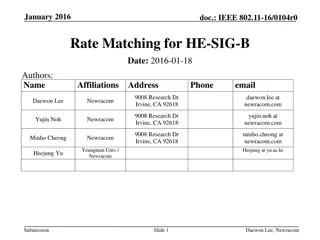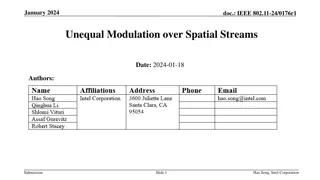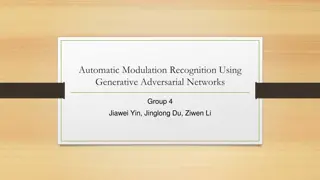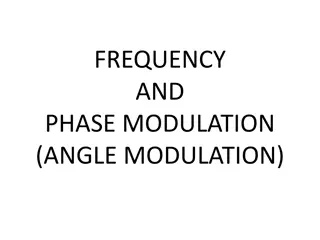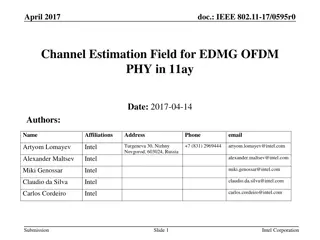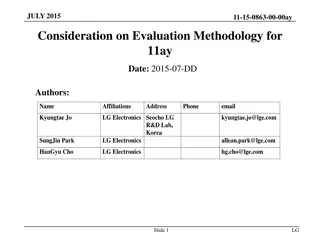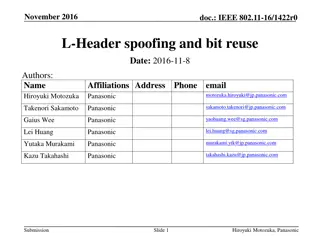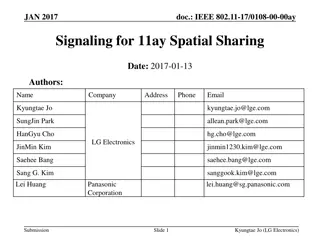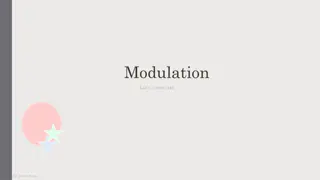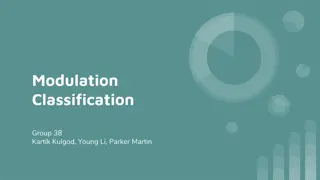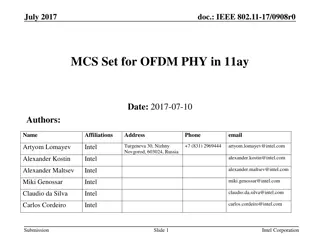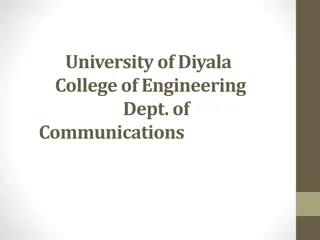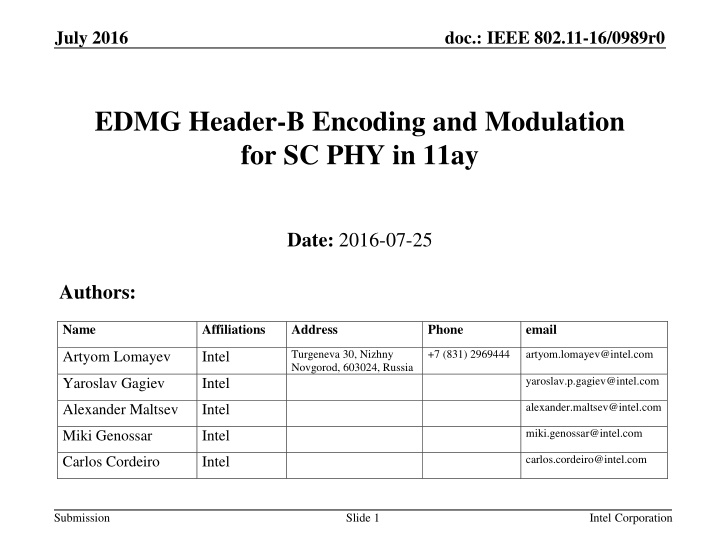
Encoding and Modulation in IEEE 802.11ay for SC.PHY Transmission
This presentation delves into the encoding and modulation techniques for SC.PHY MU-MIMO transmission in IEEE 802.11ay standard, building upon specifications from the 11ad standard. It outlines the proposed Header-B format, including scrambler seed per user, header size limitations, and other parameters. The encoding steps for EDMG Header-B are detailed, covering data scrambling, encoding, codeword generation, and bit scrambling. The resulting codeword length, scrambling, and XOR operations are also explained.
Download Presentation

Please find below an Image/Link to download the presentation.
The content on the website is provided AS IS for your information and personal use only. It may not be sold, licensed, or shared on other websites without obtaining consent from the author. If you encounter any issues during the download, it is possible that the publisher has removed the file from their server.
You are allowed to download the files provided on this website for personal or commercial use, subject to the condition that they are used lawfully. All files are the property of their respective owners.
The content on the website is provided AS IS for your information and personal use only. It may not be sold, licensed, or shared on other websites without obtaining consent from the author.
E N D
Presentation Transcript
July 2016 doc.: IEEE 802.11-16/0989r0 EDMG Header-B Encoding and Modulation for SC PHY in 11ay Date: 2016-07-25 Authors: Name Affiliations Address Phone email +7 (831) 2969444 Turgeneva 30, Nizhny Novgorod, 603024, Russia artyom.lomayev@intel.com Artyom Lomayev Intel yaroslav.p.gagiev@intel.com Yaroslav Gagiev Intel alexander.maltsev@intel.com Alexander Maltsev Intel miki.genossar@intel.com Miki Genossar Intel carlos.cordeiro@intel.com Carlos Cordeiro Intel Submission Slide 1 Intel Corporation
July 2016 doc.: IEEE 802.11-16/0989r0 Introduction This presentation defines the EDMG Header-B encoding and modulation for SC PHY MU-MIMO transmission, [1]. The proposed method is based on the encoding and modulation defined for the legacy SC PHY in 11ad standard, [2]. Submission Slide 2 Intel Corporation
July 2016 doc.: IEEE 802.11-16/0989r0 EDMG Header-B Format Proposed Header-B bit content: The exact bit content of Header-B is not defined yet; It is proposed: First 7 bits (b1, b2, , b7) define scrambler seed per user (or STA); The total header size it is proposed to limit by 64 bits; The rest of bits may define the PSDU length in bytes per user; EDMG-MCS per user; Other parameters; Submission Slide 3 Intel Corporation
July 2016 doc.: IEEE 802.11-16/0989r0 EDMG Header-B Encoding EDMG Header-B encoding steps, [2]: Data scrambling: b = (b1, b2, , b64) input bits of Header-B; s = (01, 02, 07, s1, s2, , s57) s1, s2, , s57 are first 57 bits at the output of scrambler with initial seed value (b1, b2, , b7); bs = b s; - defines bitwise XOR of two vectors; Data encoding: c = (bs1, bs2, , bs64, 01, 02, , 0440, p1, p2, , p168) LDPC codeword; HcT = 0 encoding, H is a 168 x 672 LDPC parity check matrix; c1 = (bs1, bs2, , bs64, p1, p2, , p160) codeword #1, shortening of zero bits, puncturing of tail parity bits; c2 = (bs1, bs2, , bs64, p1, p2, , p152, p161, p162, , p168) codeword #2, shortening of zero bits, puncturing of middle parity bits; Submission Slide 4 Intel Corporation
July 2016 doc.: IEEE 802.11-16/0989r0 EDMG Header-B Encoding (Cont d) EDMG Header-B encoding steps (cont d): Resulting codeword: c = (c1, c2) codeword of length 448 bits; Codeword scrambling: s = (01, 02, , 0224, s1, s2, , s224) - s1, s2, , s224 are first 224 bits at the output of scrambler with initial seed value (11, 12, , 17); cs = c s - bitwise XOR of two vectors; Submission Slide 5 Intel Corporation
July 2016 doc.: IEEE 802.11-16/0989r0 Header-B MU-MIMO Transmission Access Point (AP) transmits one stream per user: NSTS total number of space-time streams; i space-time stream index, i=1:NSTS; During MU-MIMO transmission each user (or STA) has its own scrambler initial seed value bi = (b1, b2, , b7)i depending on the space-time stream index i ; If each user has single stream, then the initial seed selection guarantees that each user will have its own unique code vector csi; Submission Slide 6 Intel Corporation
July 2016 doc.: IEEE 802.11-16/0989r0 Header-B MU-MIMO Transmission (Cont d) If AP transmits N streams per user: AP creates more than one codeword per user transmitted in different space-time streams; N codewords for N streams are obtained by the bitwise XOR operation applied to the original codeword: cs1 = c s1, cs2 = c s2, csN = c sN; c original code vector introduced above; s1 = (01, 02, , 0224, s1, s2, , s224) scrambler vector for stream #1; s2 = (s225, s226, , s672) scrambler vector for stream #2; sN = (s(N-1)*448-224+1, s(N-1)*448-224+2, , sN*448-224) scrambler vector for stream #N; All bits: s1, s2, , sN*448-224 are obtained from the output of scrambler with initial seed (11, 12, , 17); Slide 7 Submission Intel Corporation
July 2016 doc.: IEEE 802.11-16/0989r0 Header-B Modulation & Symbol Blocking Header-B modulation: Each codeword csi for space-time stream with index i is modulated using /2-BPSK modulation; It provides a SC symbol block blki of length 448 chips for the i-th stream; Each block blki is prepended with Guard Interval (GI) which is a Golay Gai64 sequence of length 64 chips; {Gai64, i=1:NSTS} comprises the set of mutually orthogonal Ga Golay sequences; This provides a regular SC symbol blocking for the i-th space-time stream as follows: [Gai64, blki]; Submission Slide 8 Intel Corporation
July 2016 doc.: IEEE 802.11-16/0989r0 Symbol Blocking for Channel Bonding Symbol blocking in case of channel bonding: NCB = 2, 3, 4 channel bonding factor; NGI CB = 64 * NCB = 128, 192, 256 Guard Interval (GI) length in case of channel bonding; The symbol block blki is repeated NCB number of times to support different channel bonding factors: NCB = 2: [Gai128, blki, blki]; NCB = 3: [Gai192, blki, blki, blki]; NCB = 4: [Gai256, blki, blki, blki, blki]; Submission Slide 9 Intel Corporation
July 2016 doc.: IEEE 802.11-16/0989r0 Conclusions This presentation defines the EDMG Header-B encoding and modulation for SC PHY. Submission Slide 10 Intel Corporation
July 2016 doc.: IEEE 802.11-16/0989r0 Straw Poll #1 Would you agree to insert the following in the SFD: The 11ay specification shall define first 7 bits of EDMG-Header-B for scrambler seed value and define the total number of bits to 64 as in the legacy 11ad header. Submission Slide 11 Intel Corporation
July 2016 doc.: IEEE 802.11-16/0989r0 Straw Poll #2 Would you agree to insert the following in the SFD: The 11ay specification shall define encoding and modulation method for EDMG-Header-B as described in the 11-16-0989-00- 00ay. Submission Slide 12 Intel Corporation
July 2016 doc.: IEEE 802.11-16/0989r0 References 1. 2. 11-15-1358-04-00ay-specification-framework-for-tgay Draft P802.11REVmc_D5.4 Submission Slide 13 Intel Corporation

